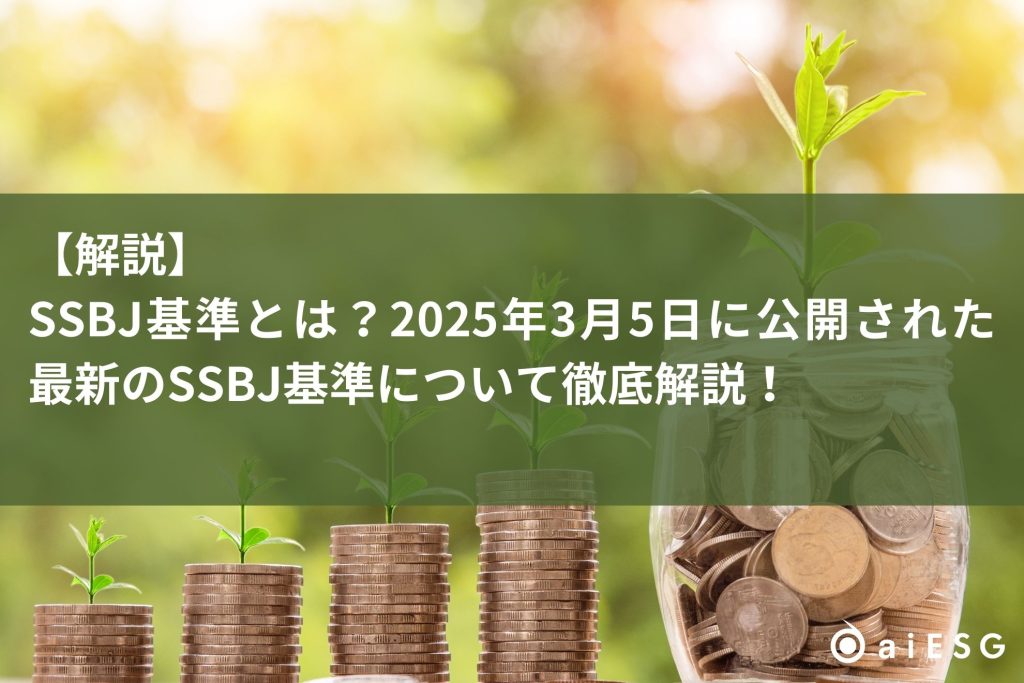INDEX
The final recommendations of the TNFD were released on September 18, 2023.
We recently provided an overview of the TNFD on this website.
【【Explanation] What is TNFD? A new bridge between finance and the natural environment
https://aiesg.co.jp/topics/report/230913_tnfdreport/
In this issue, we will introduce the TNFD reports of Japanese companies that have been released prior to the final proposal, and provide more specific information on the preparation for and issues related to disclosure.
TNFD Disclosure Companies (as of September 2023)
By disclosing information in accordance with the Taskforce on Nature-related Financial Disclosures (TNFD), companies and financial institutions can assess the relationship between their business activities and natural capital and biodiversity, and identify risks, impacts, and sustainability. This will help to clarify the risks, impacts, and sustainability of their activities. It is in the company's best interest to identify business activities and areas that are high risk to nature or to its own operations.
Even before the release of the final recommendations, several domestic companies have already disclosed information based on the TNFD. Below is a representative list of companies that have disclosed their TNFD reports by September 2023.
| Company Name | Open to the public | Report |
| Kirin Holdings Company, Limited | July 2022 July 2023 | ."Environmental Report 2022"Environmental Report 2023" |
| Sumitomo Mitsui Financial Group | April 2023 | ."SMBC Group 2023 TNFD Report" |
| Kao Corporation and Accenture, Inc. joint survey | April 2023 | ."Business Risks and Opportunities Posed by Biodiversity-TNFD Evaluation - Case Studies Based on Regional Characteristics" |
| Shiseido Company, Limited | May 2023 | ."2023 Shiseido Climate/Nature-related Financial Disclosure Report " |
| KDDI Corporation | June 2023 | ."TNFD Report 2023" |
| NEC Corporation | July 2023 | ."NEC TNFD Report 2023" |
| tokyu land holdings inc. | August 2023 | ."TNFD Report〜Tokyu Land Holdings GroupContribution to Nature Positive ~." |
| Kyushu Electric Power Group | September 2023 | ."Kyuden Group TNFD Report 2023" |
TNFD Report Type
For more information on the detailed configuration of the TNFD, please contactPrevious Reportbut the four pillars of the disclosure recommendations, governance, strategy, risk and impact management, and selection indicators and targets, are central to the disclosure recommendations (Figure 1).

Figure 1: Draft TNFD Disclosure Proposal (Source: TNFD Full Beta Summary v0.4 Japanese version)
Many of the existing reports attempt to follow these recommendations. Several companies have also taken a hands-on approach to the LEAP approach, Discover, Diagnose, Assess, and Prepare (Figure 2), which is recommended to help assess nature-related risks and opportunities.

Figure 2: LEAP Approach (Source: TNFD Full Beta Summary v0.4 Japanese version)
There are several possible patterns of disclosure in the report, depending on the information currently available.
The ideal form would be to calculate as many indicators as possible for the entire entity and describe explanations and quantitative evaluations in line with disclosure recommendations. While this is the format we should ultimately aim for, it is not easy to collect nature-related indicators for the entire supply chain. Only a limited number of organizations, such as companies with a proven track record of regularly releasing detailed ESG and environment-related reports in the past, will be able to reach perfect disclosure.
In other cases, we may identify high-risk businesses or regions first, and report on them on a priority basis. In fact, many corporate reports take this approach. Narrowing the scope of investigation by materiality can reduce the cost of disclosure, but the path and rationale for identifying them must be clearly explained. The LEAP approach can also be used at this stage to make the argument more persuasive.
On the other hand, a report that focuses mainly on case studies could be considered. By focusing on the risks and specific initiatives for each scenario, it is possible to make disclosures related to the TNFD even when it is difficult to prepare quantitative indicators. However, if the information is not in line with the basic recommendations required, the TNFD report may be inadequate.
Report Disclosure Examples
This section presents a more specific look at the contents of some TNFD reports. In addition to the general requirements and disclosure recommendations, there are various attempts to use the LEAP approach according to each company's interpretation, but what are the actual examples?
Disclosure Example 1: Kirin Holdings "Integrated Environmental Management Information Disclosure based on the TCFD Framework, TNFD Framework Draft, etc." from "Environmental Report 2023" [1].
https://www.kirinholdings.com/jp/investors/files/pdf/environmental2023_03.pdf
| proposal | summary |
| General requirements | Almost fulfills the requirements, although there are no corresponding parts. |
| governance | Introduction of supervision and execution systems and risk management systems |
| strategy | Risk and impact assessment, scenario analysis, approach, transition planning |
| Risk and Impact Management | Physical/transition risks and response strategies are presented by scenario in the "Risk Management" chapter. |
| Metrics and Targets | Targets and results by type, investment plans |
Kirin is the first company in the world to experiment with TNFD-compliant disclosure in July 2022 [2]. In this issue, we summarize the features of the report for the 2023 edition.
⚫︎TCFD (Task Force on Climate-related Financial Disclosures) and TNFD collectively disclose
These frameworks, which share the same pillars of disclosure recommendations, overlap in many areas throughout a company's efforts, and these methods can be efficient. However, there is a risk that it may become unclear which framework is followed.
⚫︎Define the target project and time frame at the beginning.
The scope of the report's assumptions will be clear.
⚫︎Use of tools recommended by TNFD
The chapter "Risk and Opportunity Analysis for Natural Capital" begins with the use of ENCORE [3] to show the dependence and impact of the entire group in its area of operations.
⚫︎Using the LEAP Approach
Based on the ENCORE screening results and actual local conditions, the analysis applies the LEAP approach recommended by TNFD for tea leaf production areas in Sri Lanka.
While the report as a whole conforms to the general requirements and the four pillars of disclosure recommendations in considerable detail, quantitative disclosure of core indicators has not yet been fully addressed, and the report aims to further improve the accuracy of the report through trial disclosure of indicators that are considered to be relevant.
Disclosure Example 2: Kyushu Electric Power Company "Kyuden Group TNFD Report 2023[4]
https://www.kyuden.co.jp/var/rev0/0448/2017/v5m2tdk4.pdf
| proposal | summary |
| General requirements | Particular reference to "integration with other sustainability issues |
| governance | Introduction of Sustainability Promotion Committee, Environmental Management System, etc. |
| strategy | Assessment of Impact and Dependency per Power Generation Project |
| Risk and Impact Management | Assessment of risk for each power generation project |
| Metrics and Targets | Specify correspondence with core indicators, targets related to natural capital |
Kyushu Electric Power Company released its TNFD report in September 2023. Electric utilities are also included in the TNFD's proposed priority sectors (industries where compliance with the TNFD is a priority recommendation) and are one of the sectors with the greatest interactions with natural capital. This report has the following features.
Define eligible projects at the beginning of ⚫︎
The scope of what the report assumes is clear. Even within the report, the risk assessment for each power generation project makes the structure easier to understand.
Use of tools recommended by ⚫︎TNFD
In the chapter "Natural Capital-Related Impacts and Dependencies," we use ENCORE to create heat maps of the impacts of direct operations and fuel procurement on natural capital and dependence on ecosystem services.
⚫︎ introduces its own evaluation criteria
The heat map is updated by introducing additional individual items such as company-specific conditions and the likelihood of natural disasters to the ENCORE results above.
⚫︎Introduction of our company's initiatives
The "Opportunities for Natural Capital" chapter specifically describes natural capital-related initiatives that companies are undertaking.
The report is relatively focused on explaining the impact of each risk and the basis for making assessment decisions (risk and impact management). Figures corresponding to core indicators and other information are shown by directing the reader to the ESG Data Book.
Hurdles to TNFD report release
Through this analysis of existing reports, we have identified a variety of challenges that companies may face. Three of the major hurdles that we believe are common regardless of industry or company size are as follows
Issue 1: Determination of priority areas and projects
As we have mentioned, it is difficult for many companies to conduct a complete retrospective analysis of the value chain regarding all business areas from the beginning. One solution is to narrow the scope of information disclosure, but in such cases, a rationale is needed for the decision.
Tools such as ENCORE, used in the above report, are often used as an initial means of understanding the connection between a company's business and nature, as they have the advantage of providing a rough idea of which regions and business areas are most at risk. On the other hand, they cannot analyze detailed indicators or reflect the characteristics of one's business. More granular measures need to be considered in order to make a sufficiently convincing priority determination.
Issue 2: Content of disclosure recommendations
The decision on what and how much to disclose in each of the four pillars of the disclosure recommendations and the 14 underlying recommendations currently depends largely on the interpretation of the company. In particular, it is difficult to draw a line between the two pillars of "Strategy" and "Risk and Impact Management," and to determine the order in which they should be listed. Some companies, such as Kyushu Electric Power Co., have dared to create reports that do not clearly correspond to the two pillars as sections. It is expected that a general format will be gradually established through feedback from TNFD and investor groups.
Issue 3: Measuring Core Indicators
In addition to the Global Core Disclosure Indicators, which are strongly recommended for disclosure across all businesses, TNFD publishes sector- and biome-specific disclosure indicators. These indicators require quantitative data and the required content can range from land use and pollutant emissions to the percentage of assets exposed to nature-related risks.
The hurdle is relatively low for companies that already publish annual ESG-related reports or have a detailed understanding of their supply chain, but even so, disclosure that fully meets the required indicators has yet to be made.
The ESG analysis provided by aiESG is based on proprietary big data, and enables visualization and identification of hotspots of high risk areas, tracing back to the end of the supply chain. The approximately 3,200 ESG indicators include not only greenhouse gas emissions and other indicators that can be measured by conventional services, but also community impacts, indigenous rights, and other factors, enabling a quantitative understanding of the social aspects required by the TNFD.
Conclusion
The TNFD is expected to be a disclosure framework that is easily accepted by both companies and investors, as it shares common recommendations with the TCFD, which many companies already comply with. The TNFD is expected to be a disclosure framework that is easily accepted by both companies and investors. Now that the steps toward disclosure are becoming increasingly concrete with the release of the final proposal, it is important to start discussions on disclosure as soon as possible.
aiESG provides support from the basics of TNFD to the actual disclosure of non-financial information, so if your company is having trouble with TNFD, please contact us.
Contact us:
https://aiesg.co.jp/contact/
Bibliography
[1] https://www.kirinholdings.com/jp/investors/files/pdf/environmental2023_03.pdf
[2] https://project.nikkeibp.co.jp/ESG/atcl/column/00005/080500243/
[3] ENCORE (Exploring Natural Capital Opportunities, Risks and Exposure)
A risk assessment tool jointly developed by the United Nations Environment Programme World Conservation Monitoring Center (UNEP-WCSC), the Natural Capital Finance Alliance (NCFA), and others.
https://www.encorenature.org/en
[4] https://www.kyuden.co.jp/var/rev0/0448/2017/v5m2tdk4.pdf
[5] https://www3.weforum.org/docs/WEF_New_Nature_Economy_Report_2020.pdf
Related page
【【Explanation] What is TNFD? A new bridge between finance and the natural environment
https://aiesg.co.jp/topics/report/230913_tnfdreport/
Commentary] Key Points of the TNFD Final Recommendations and the Responses Required of Companies
https://aiesg.co.jp/topics/report/231106_tnfdreport3/
aiESG Participates in the Task Force on Nature-related Financial Disclosures (TNFD) Forum
https://aiesg.co.jp/topics/news/2309_tnfd/
















